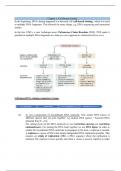Chapter 1: Cell-based cloning
In the beginning, DNA cloning happened in a bacterial cell (cell-based cloning), which was used
to multiply DNA fragments. This allowed for many things, e.g. DNA sequencing and expression
studies.
In the late 1990’s, a new technique arose: Polymerase Chain Reaction (PCR). PCR made it
possible to multiply DNA fragments in a tube (in vitro) opposed to a bacterial cell (in vivo).
Cell-based DNA cloning comprises 4 steps:
In vitro construction Transformation Selective propagation of clones Purification DNA from host
(I) In vitro construction of recombinant DNA molecule. This entails DNA pieces of
different species that you join together, e.g. human DNA (gene) + bacterial DNA
(plasmid from E. coli).
For cutting (lysis) of the DNA molecule we use restriction enzymes (or restriction
endonucleases). For pasting the DNA back together we use DNA ligase. In order to
enable the recombinant DNA molecule to propagate in the host, a replicon is needed.
A replicon is a piece of DNA that makes independent DNA replication possible. This
requires an origin of replication (ORI), a DNA sequence where the replication is
initiated. The replicon is host specific and often a vector is used as replicon to make
, the recombinant molecule. A vector is a piece of extrachromosomal DNA, like a
plasmid or bacteriophage in bacterial host cells.
(II) Transformation. The recombinant DNA molecule is introduced in the host cell, which
is usually a bacterial cell but it also works in some eukaryotic cells. Bacteria and yeast
are used because (+) they’re easy to grow; exponential growth which only requires air
and growth formula/culture medium, and (+) have fast reproduction.
The host cell will not only multiply their own chromosome, but also the recombinant
DNA molecule which is implemented in the vector (plasmid).
(III) Selective propagation of clones. Here, you manually pick out the bacteria individually
each with a specific DNA sequence. Then, you plate those bacteria in a culture on an
agar plate.
Each colony is a clone: all cells are identical and have the same ancestor cell. You can
obtain more clones of a type of bacterium that contains one type of insert, by growing
a colony in liquid medium.
There are plenty of ways to pick colonies, e.g. hybridization assays. First you put a
filter on top of the colonies lift filter off hybridize it (i.e. with Southern Blot and
probe with fluorescent label for gene of interest with fluorescent label see which
colony contains which gene pick colony and grow it multiply to obtain more
DNA
, (IV) Purifying DNA by isolating the recombinant DNA clones from the host. Not always
necessary for some procedures e.g. expression studies in eukaryotic host cells, because
there you only have to look at the cell expression and don’t need the recombinant DNA
itself. In this step, bacterial host cells are lysed and then purified for the recombinant
DNA molecules. The way the DNA is purified from the host cell also depends on the
vector you used (e.g., plasmid is the -easiest to extract DNA from, and is also used the
most).
Restriction enzymes/endonucleases (RE):
Restriction enzymes (RE) are usually found in bacteria in nature. The bacteria use RE as a defense
mechanism against bacteriophages from viruses. RE are able to cut the bacteriophage (phage) but
spare their own bacterial DNA. This way, viral DNA will be cut and destroyed bacterium will
survive.
How can bacteria make this sequence without cutting its own DNA? Bacteria typically have
methylase: bacteria will methylate the matching sequence in its own genome bacterial DNA is
methylated at these sequences and thus won’t be cut by their RE. Phages are not methylated at
these sequences will be cut.
The recognition site is usually a palindrome (same if you read it from both directions), a word or
sentence that remains the same backwards (e.g. a man canal panama, race car, step on no pets, …),
so antiparallel strands 5’ 3’ and vice versa. RE cut the DNA by cleaving the phosphodiester
bonds in the DNA molecule. This can be done in 2 ways:
− On the middle of the symmetry axis of the palindrome blunt ends
- Not on the symmetry axis sticky ends.
Blunt ends Sticky ends
Also called Cohesive ends Non-cohesive ends
Formation RE makes cut exactly in the middle RE makes cut not exactly in the middle
of the symmetry axis of palindrome of the symmetry axis of palindrome
Physical No overhangs or unpaired bases Ends feature overhangs allows to
characteristics base-pair ends together and join with
another DNA strand
Pairing No unpaired DNA strand Unpaired DNA nucleotide either on
5’- or 3’- strand (5’- or 3’- overhang)
, You can reverse the reaction of RE by joining sticky ends with DNA ligase. However, you have a
solution with many other cut molecules so you cannot always really get the same two molecules
back together the way they were.
Nomenclature of RE: 1 letter genus, 2 letters species, followed by Roman number. Example:
Hemophilus aegypticus III HaeIII
Type II RE are normally used in labs, (+) because they cut a specific recognition sequence that’s
usually between 4 – 8bp in size so we know exactly where the cut will be made. (+) RE are usually
cheap and (+) reliable, they’re evolutionary proven to be successful – no cuts on the same place so
no mistakes.
Some examples of RE that are frequently used in the lab: HaeIII, MboI, BamHI, PstI
- HaeIII cuts right in the middle blunt ends
- Remember! The sequences are always read from the 5’
3’ end! DNA polymerase always adds bases to the 3’ end.
- You cannot ligate 3’ overhand end with 5’ overhand.
- You can ligate cuts of two different RE, but only possible
when they have compatible overhangs! (seldom, but not
impossible)
- The first RE was found in Escherichia coli = EcoRI
- RE from different bacteria but with same recognition
sequence are called isochizomeres (choose cheapest/most reliable)




